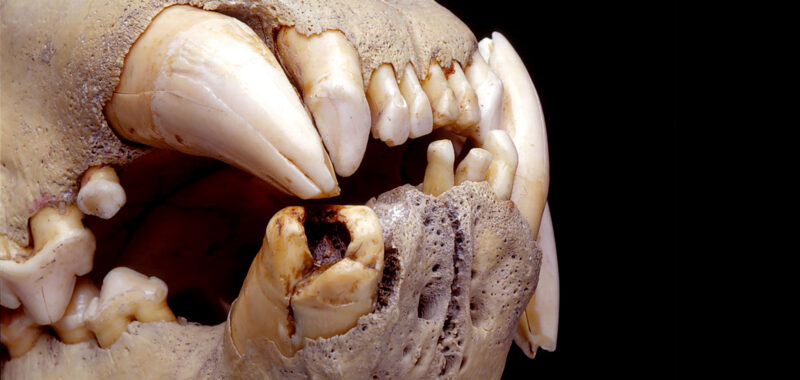Over a century ago, two giant male lions called the Tsavo “man-eaters” killed at least 28 people over the course of about nine months. New DNA sequencing using tiny hairs that were carefully extracted from the lions’ broken teeth has revealed that the predators ate humans, wildebeests, giraffes, and more. The findings are detailed in a study published October 11 in the journal Current Biology.
The tale of the Tsavo ‘man-eaters’
In 1898, a group of bridge builders set up camp on the Tsavo River in Kenya. From March to December, two large and maneless male lions stalked the group. Some nights, they went into the camp and dragged their victims out of their tents. They are responsible for at least 28 deaths. The project’s civil engineer Lt. Col. John Henry Patterson, eventually shot the lions and sold their remains to the Field Museum of Natural History in Chicago in 1925.
[Related: Man-eating lions might like us because we’re squishy.]
During the early 1990s, Field Museum collections manager Thomas Gnoske took the lions’ skulls out of storage in search of more evidence of what they had consumed. This re-examination helped him determine that the lions were fully grown older adult males–despite neither of them having a mane. Gnoske also noticed that thousands of broken and compacted hairs had built up in exposed cavities in the lions’ teeth during their lifetimes.
In a 2001 study, Gnoske and Julian Kerbis Peterhans, a biologist from Roosevelt University and an adjunct curator at the Field Museum, described the damaged condition of the teeth and the presence of the hairs within them. The analysis of the hairs indicated that they ate eland, impala, oryx, porcupine, warthog, and zebra.

Splitting hairs
In this new study, Gnoske and Peterhans worked alongside a team in Kenya and the University of Illinois to examine some of the hairs. Co-authors Ogeto Mwebi from National Museums of Kenya and Nduhiu Gitahi from the University of Nairobi, conducted the microscopic analysis of the hairs. University of Illinois postdoctoral researcher Alida de Flamingh led a genomic investigation of the hairs, alongside anthropology professor Ripan S. Malhi.
The team focused on a separate sample of four individual hairs and three clumps of hairs that were extracted from the lions’ teeth. de Flamingh first looked for the familiar hallmarks of age-related degradation in what remained of the nuclear DNA in the hairs from the lions’ teeth.
“To establish the authenticity of the sample we’re analyzing, we look to see whether the DNA has these patterns that are typically found in ancient DNA,” de Flamingh said in a statement.
The samples were authenticated and de Flamingh then focused on mitochondrial DNA (mtDNA). The mitochondrial genome is inherited from the mother in humans and other animals. This makes it useful for tracing back matrilineal lineages through time.
According to the researchers, there are several advantages to focusing on mtDNA in hair. Earlier studies have found that hair structure preserves mtDNA and protects it from contamination. MtDNA can also be significantly more abundant than nuclear DNA found in cells.
“And because the mitochondrial genome is much smaller than the nuclear genome, it’s easier to reconstruct in potential prey species,” said de Flamingh.
The team constructed a database of the mtDNA profiles of the lion’s potential prey species. They then compared this to a reference database with mtDNA profiles taken from the hairs in the lion’s teeth.
[Related: Lion brothers take risky swim across crocodile-infested channel.]
“We were even able to get DNA from fragments that were shorter than the nail on your pinky finger,” de Flamingh said.
“Traditionally, when people want to get DNA from hairs, they’ll focus on the follicle, which is going to have a lot of nuclear DNA in it,” Malhi said in a statement. “But these were fragments of hair shafts that were more than 100 years old.”
From this technique analyzing the hair’s DNA, the team identified giraffe, human, oryx, waterbuck, wildebeest and zebra as prey. They also pinpointed hairs that originated from lions. The lions had consumed at least two giraffes, along with a zebra that was likely from the Tsavo region.
The lions also share the same maternally inherited mitochondrial genome, which supports early theories that they were siblings. Their mtDNA also was consistent with an origin in Tanzania or Kenya.
Surprise finds
The wildebeest mtDNA was a bit of a surprise. During the 1980s, the nearest population of wildebeests was roughly about 50 miles away. However, historical reports noted that lions would leave the Tsavo region for about six months before they continued to hunt in the bridge-builders’ camp. Another surprise was the absence of buffalo DNA and the presence of only a single buffalo hair. For today’s Tsavo lions, buffalo is their preferred prey.
[Related: America used to have its own lions. Where did they go?]
“Colonel Patterson kept a handwritten field journal during his time at Tsavo,” Peterhans said in a statement. “But he never recorded seeing buffalo or indigenous cattle in his journal.”
The cattle and buffalo populations in this part of Africa at this time were devastated by rinderpest. This highly contagious viral disease was brought to the continent from India by the early 1880s. According to Peterhans, rinderpest all but wiped out the cattle and their wild relatives.
The human impact
The scientists declined to describe or analyze the human hairs found in the lions’ teeth any further.
“There may be descendants still in the region today and to practice responsible and ethical science, we are using community-based methods to extend the human aspects of the larger project,” the team wrote.
These new findings expand the kinds of data that can be extracted from skulls and hairs from the past. Since there were thousands of hairs embedded and compacted in the lions’ teeth, further analyses will allow the scientists to at least partially reconstruct the lions’ diet and possibly identify when their habit of preying on humans began.

